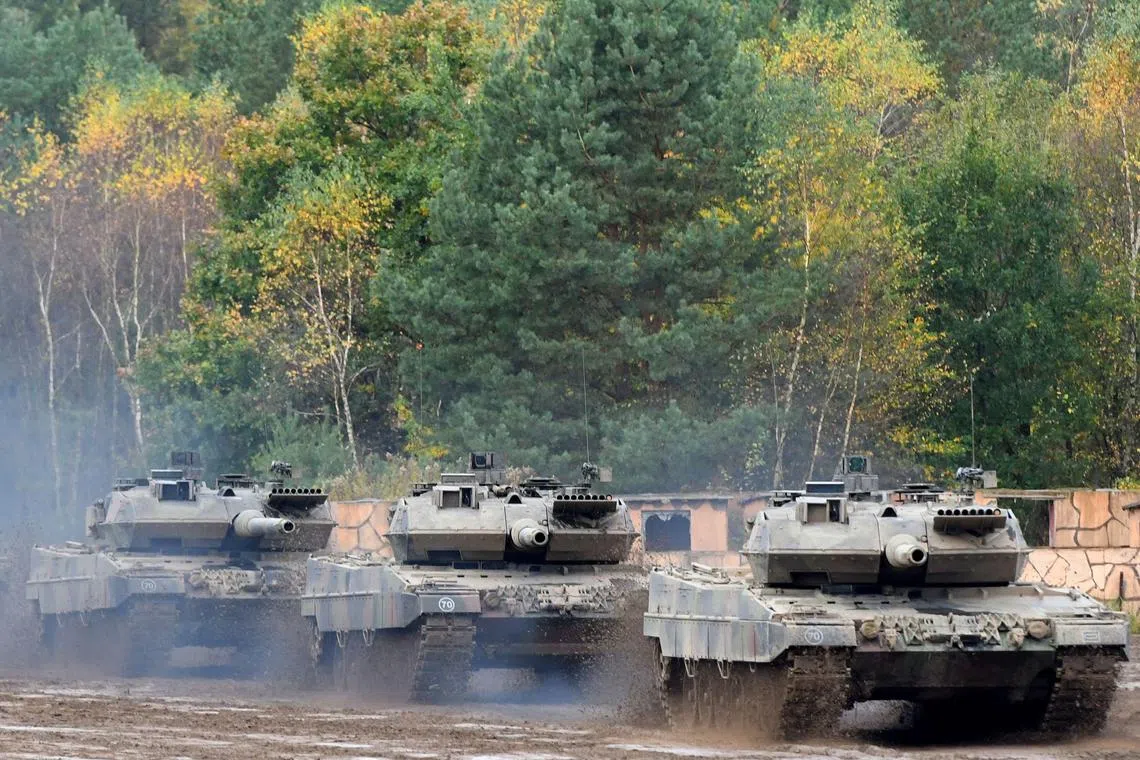Why tanks for Ukraine are tripping up the West
Sign up now: Get ST's newsletters delivered to your inbox

Germans are sharply divided over sending German-made Leopard 2 tanks to Ukraine.
PHOTO: AFP
Follow topic:
BERLIN – Canada is sending 200 personnel carriers. Britain will donate 600 missiles. Sweden is giving artillery systems and armoured vehicles. And in one of its single largest security commitments since the start of the war, the United States said on Thursday it will ship about 100 additional fighting vehicles to help Ukraine repel Russian advances.
But so far missing from a new weapons package that officials from North Atlantic Treaty Organisation states will reaffirm at the Ramstein Air Base in Germany on Friday are US- and German-made tanks that Ukraine’s leaders say are desperately needed – an issue that is expected to be central to the talks.
Mr Ben Barry, a ground warfare expert at the International Institute for Strategic Studies in London, said the pressure campaign by Ukraine and its immediate neighbours in Eastern Europe harkened back to a lesson from World War II, when the US supplied the British Army with Sherman tanks to beat back enemy forces in Europe and North Africa.
Now, Mr Barry said, President Volodymyr Zelensky of Ukraine is banking on a similar appeal.
“It’s the same message: ‘Give us the tools and we will finish the job’,” Mr Barry said.
Here is a look at the debate over sending tanks to Ukraine.
Why are tanks so important for Ukraine?
Following pitched battles for control of territory over the past year, officials said it was clear that tanks would be crucial in pushing back Russian forces. That has taken on increased importance this winter, given a limited window for Ukraine to seize an advantage before Russia deploys hundreds of thousands of newly conscripted soldiers in an anticipated spring offensive.
Ukraine’s most senior military commander, General Valery Zaluzhny, has said his forces need about 300 Western tanks to make a difference in battles for fiercely contested cities and towns in the eastern provinces that border Russia. Over the past year, Nato allies in Eastern Europe supplied Ukraine with Soviet-era and Russian-made tanks that have been ground down or destroyed in constant fighting.
Why is Germany so reluctant to send tanks?
Germany has long refused to send its most potent weapons to countries in conflict, a by-product of its legacy of starting World War II. That has included prohibiting the export of its Leopard 2 tanks to Ukraine – even those that have been sold to other armies. The reluctance also reflects a sharp division among Germans – as indicated in recent polling – over sending battle tanks to Ukraine despite widespread support for providing other weapons.
German Chancellor Olaf Scholz has repeatedly said he would not “go it alone” when it comes to sending weapons into Ukraine, and would only act in concert with allies.
In practice, that has more narrowly meant that he will not act without Washington. This week, German officials said Mr Scholz has insisted that Berlin will not send any of its own Leopard tanks unless the US sends its M1 Abrams tanks as well.
What is not yet clear is whether Mr Scholz would allow other nations to send their Leopards without sending any itself. Poland and Finland have already said they would donate the tanks from their own stockpiles if Berlin issues licences to re-export them.
Experts believe there are an estimated 2,000 German-made Leopard 2 tanks in use by at least 13 European militaries.
Will Washington send US-made tanks to Ukraine?
That is not expected any time soon, according to two US defence officials, if ever.
On Thursday, US officials said they would send about 100 additional fighting vehicles – known as Strykers and Bradleys – to Ukraine. That is on top of 50 Bradleys the US pledged earlier in January.
A senior administration official said the new vehicles were not meant to assuage Ukraine’s demands for tanks but, rather, to provide other equipment that would prove useful on the battlefield.
The Biden administration has long asserted that US-made M1 Abrams tanks – with their needs for specific fuel, frequent maintenance and spare parts, transport and training – are ill-suited to battle in eastern Ukraine, where supply lines could easily be cut off.
A Pentagon spokesman, Ms Sabrina Singh, told reporters on Thursday that “it just doesn’t make sense” to provide Ukraine with Abrams tanks “at this moment” because they use jet fuel and are difficult to maintain. She said the Germans must make up their own minds about the Leopard 2s.
More broadly, officials worry that American tanks would be seen as a sign of escalation by the US – a risky step for a global superpower that is trying to avoid a broader conflict.
But Mr Max Bergmann, a former US diplomat and expert on European and Russian security at the Centre for Strategic and International Studies in Washington, said Washington had already crossed that line with its shipments of precision-guided missiles and other advanced weaponry.
“This is sort of a boiling frog,” Mr Bergmann said on Thursday. “They’ve already escalated – they’ve raised the escalatory roof.” NYTIMES

